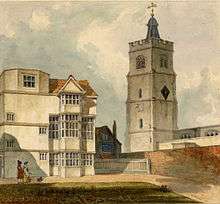Church of St John-at-Hackney
| Church of St John-at-Hackney | |
|---|---|
 Portico and tower of the Church of St John-at-Hackney | |
| Location | London Borough of Hackney |
| Country | United Kingdom |
| Denomination | Church of England |
| Website | stjohnathackney.org |
| Architecture | |
| Architect(s) | James Spiller |
| Years built | 1792 |
| Administration | |
| Parish | Hackney |
| Diocese | Diocese of London |
| Clergy | |
| Bishop(s) | the Bishop of London |
| Rector | Al Gordon |
| Curate(s) | Sue Makin, Assistant Curate |
The Church of St John-at-Hackney is in the heart of the London Borough of Hackney with a large capacity of around 2,000. It was built to replace Hackney's medieval parish church, of which St Augustine's Tower remains, at the edge of its park (former churchyard). When it was built in 1792 it was in a large open field around which trades operated including a corn chandler and butcher. The church entrance faces north, across its park and an open road to Clapton Square. It shares in the same green-focussed Conservation Area; together the green areas provide the main open space to the neighbouring houses and apartments and serve as a park to parts of Hackney Central and Lower Clapton. The park with the church has been used for large national charity fundraising concerts annually and is engaged in a number of outreach projects in Hackney's communities.
History
The Church of St John-at-Hackney was designed by James Spiller and built in 1792,[1] when demand was in excess of 3,000 parishioners. Hackney Parish soon therefore spawned many ecclesiastical offspring but at an original 3,300 acres (13 km2) was the largest civil parish of Middlesex of those which joined the County of London (created in 1889).[2] The vast, classical, stock-brick building, on a Greek Cross plan, can hold around 2,000 people.[1]
The former churchyard forms a complex of gardens awarded Heritage Green Site status in 2008.[3] These look upward, to the north, across an open road to Clapton Square and it shares in the Clapton Square Conservation Area;[3] these provide the main open space to the adjoining houses and apartments and the main park to parts of Hackney Central and Lower Clapton.[3]
The building is Grade II* listed and has monuments dating from Tudor times transferred from the demolished church which was at the edge of the gardens.[1]
St Augustine's Church

It is possible that a chapel stood here serving the small, prosperous manor of Hackney north of the City of London, before the Norman Conquest. No records survive of a conceivable chapel before 1275 for a chapelry within the parish of Stepney which covered the 13km² of Hackney, see St Dunstan's, Stepney. From the 14th century the church was dedicated to Saint Augustine of Hippo until, in 1660, it was rededicated to Saint John the Baptist, later becoming more commonly known as St John-at-Hackney.[2]
In the 13th century much of the land around Hackney formed part of the possessions of the Knights Templar. When the order was disbanded its possessions were passed to the Order of St. John of Jerusalem, who had a mansion on Church Street. The Order of St John began with the First Crusade to the Holy Land in 1095. When the crusaders captured Jerusalem, the order founded a hospice which took on its lands; in 1113, the Pope recognised it as an independent religious order of monks and nuns, The Order of St John, whose special task was to care for the sick. At the Dissolution of the Monasteries the lands passed to the Crown and were parcelled amongst Tudor nobles, including Thomas Sutton and Ralph Sadler.[2]

Growing congregation
Hackney's proximity to the City of London and the royal court made it popular with courtiers, city merchants and businessmen. An increasing number of private schools were established in some of the older houses. By 1789 the church capacity, with the addition of numerous galleries, had reached 1,000. This, however, was not enough.[2]

In 1779 a surveyor, Richard Jupp, proposed a rebuilding to increase the capacity to 1,480, but no action was taken. By 1788 a committee found that the population of the parish had increased so much that the church should seek to seat 3,000. The appointed architect, William Blackburn, firmly rejected the idea of building on the old site, advising that a budget of £15,000 be created to buy land on which to construct a new church.[2]
In April 1789 the committee put the matter to a parochial vote, winning their case by 313 votes to 70. A bill was put to the House of Commons. Opponents of the proposal undertook yet another survey with a view to rebuilding on the old site. Finally a compromise was reached; the bill became an act empowering the trustees to acquire, for £875, Church Field which lay to the north-east of the existing churchyard. The existing tenants, a butcher and corn chandler, were given three months to move.[2]
New church
_p5.029_-_Hackney_Church%2C_Middlesex.jpg)
A new church, tower and vestry room would be built within three years of laying the foundation and the old church then demolished. In the event the initial estimates of costs were significantly incorrect and two further acts had to be passed through Parliament to allow extra money to be raised.
William Blackburn died suddenly in November 1790; a month later James Spiller, influenced by and a friend of Sir John Soane, was chosen from six architect candidates; Hackney church was his largest project to date and remains Spiller's magnum opus. Believing that a building seating 3,000 would have poor acoustics, he persuaded the trustees to allow him to reduce the capacity to 2,000, but remained convinced that the acoustics would not be good unless the church was full.
Work began in 1792 and the main structure took more than two years to complete. On 15 July 1797 the church was consecrated. A wooden box-like structure was later added in the place for the tower.
Harry Sedgwick, a trustee, oversaw a subscription for planting the churchyard. 129 subscriptions enabled nearly 200 elms and horse chestnuts to be planted in avenues. Sedgwick was later buried in the churchyard; and his planting achievement is commemorated on his tomb. Sedgwick lost his only son in action in the Napoleonic War; he has an elaborate memorial inside the church.
In March 1798 the body of the old church was demolished and several of the tombs removed to the new church. The tower remained - left intact to hold the bells as funds did not allow building a tower on the new church. In 1814 the tower was added to the church and, in 1816, a stained glass east window was installed behind the altar.
The old tower of St Augustine's Church remains standing and plays a symbolic and ceremonial role in Hackney: it has adorned the masthead of the Hackney Gazette since its foundation in 1864 and is incorporated in the coat of arms of the London Borough of Hackney.
In 1902 the church was renovated and had electric lights installed, the repairs and alterations costing ₤1,823.[4]
Fire damage and repairs
On 18 May 1955 a fire started in the church roof, destroying the roof, many of the pews and the 1799 organ by George Pike England. During the ensuing major reconstruction work there was some reordering of the interior.
A replacement three manual Mander organ came from All Saint's Ennismore Gardens, Kensington; altar hangings designed for the coronation of Queen Elizabeth II at Westminster Abbey were donated; and the east window replaced by a new one designed by Christopher Webb. The new church was reconsecrated on 24 June 1958 (St John's Day).
Repair work was carried out on the roof, in 2004, funded by English Heritage. An electrical fire in January 2006 caused minor damage to the church and the organ still needs checking for smoke damage. The fabric of the 200–year old church still requires major maintenance and the parish has prepared an action plan to raise money and proceed with refurbishment and adaptation of the building to the modern needs of the parish.
At the fête on 5 July 2008, the church and its churchyard were rededicated by the Archdeacon of Hackney, in celebration of the 50th anniversary of the reconstruction and the major works undertaken to regenerate the church gardens over the previous year. St John's Church Gardens, around the tower and church, were awarded both a Green Flag award and Green Flag Heritage status in 2008.
Operation of the church
- Clergy and lay ministers
- Rev. Al Gordon — Rector, appointed 2016
- Rev. Sue Makin — Assistant Curate.
- Numerous lay ministers such as Readers also administer services such as funerals for the church
- Ministry and building alterations
St John-at-Hackney wrote and promoted in 2013 a five-year plan to make the building fit for purpose and refocus on community ministry projects to ensure the church continues to bring in and serve troubled and destitute people as well as settled and affluent people: Oasis Vision 2018.
- National charities and concerts
In 2011 the church hosted the Little Noise Sessions in aid of Mencap. The concerts featured: Elbow, Marina and the Diamonds, Goldfrapp, Example, Coldplay and Sinéad O'Connor presented by Jo Whiley. Events in later years have included Florence and the Machine, Bloc Party, and Rufus Wainwright.
Notable burials at the church before rebuilding
- David Dolben (d.1633), a Welsh Bishop of Bangor where his monument, containing a half-length statue and a eulogistic description of him, still stands
- Timothy Hall (d.1690), bishop
References
- 1 2 3 Historic England. "CHURCH OF ST JOHN (1226959)". National Heritage List for England.
- 1 2 3 4 5 6 Hackney: The Parish Church, A History of the County of Middlesex: Volume 10: Hackney (1995), pp. 115-122 accessed: 26 July 2008
- 1 2 3 "Clapton Square Conservation Area" The London Borough of Hackney
- ↑ "Ecclesiastical intelligence". The Times (36891). London. 6 October 1902. p. 5.
Sources
- Guide to the Local Administrative Units of England, Vol.1, Frederic Youngs, London, 1979
External links
| Wikimedia Commons has media related to Church of St John-at-Hackney. |
Coordinates: 51°32′57″N 0°03′12″W / 51.549224°N 0.053360°W